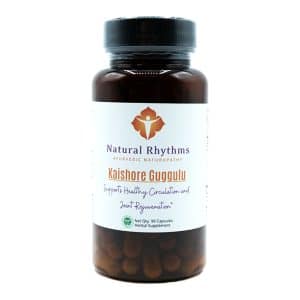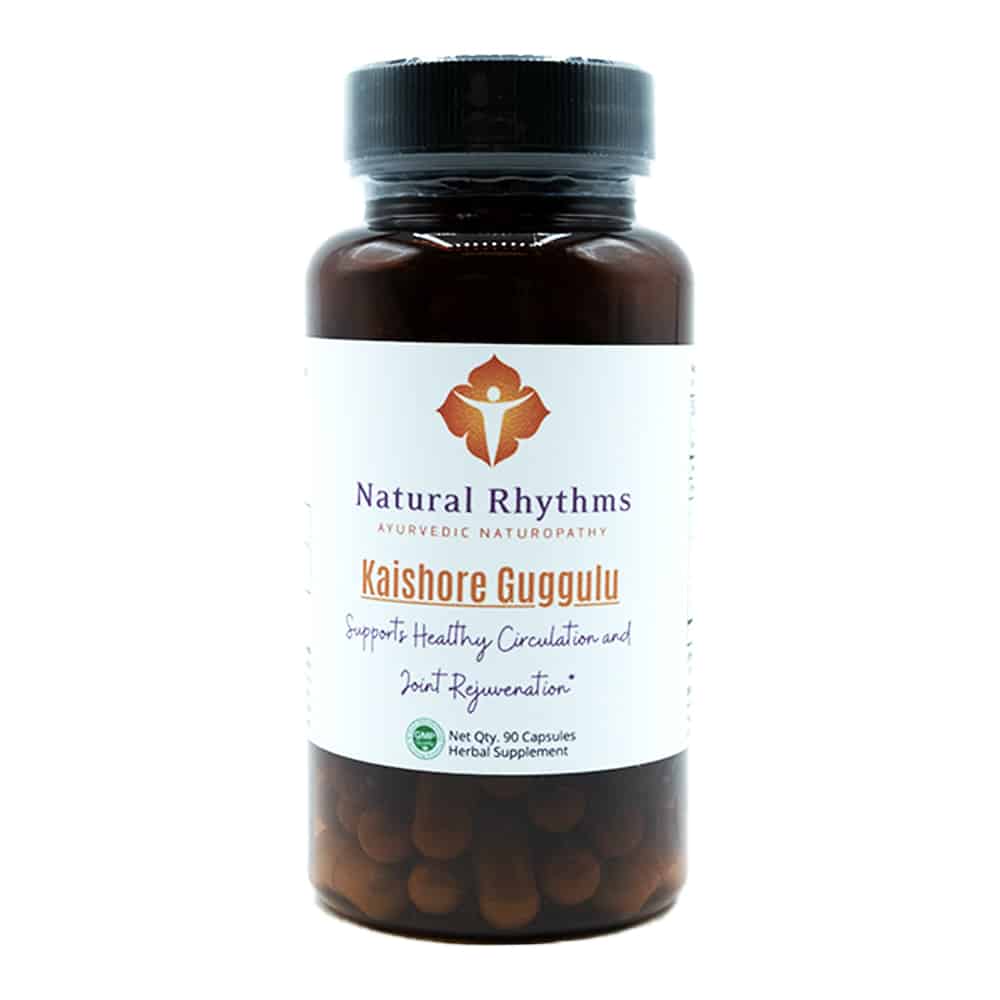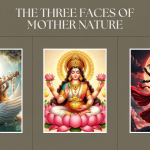
Kaishore guggul is one of most prominent and prolific Guggulu-based formulations in Ayurvedic medicine. It is well reputed for use in management of arthritic conditions, skin conditions, vascular disorders, non-healing wounds, and so much more.
Prominent herbs in this formulation are Guduchi, Guggul, Triphala, Trikatu. This combination of herbs instill the unique actions of this formulation: Guduchi is a liver/blood rejuvenating herb that focuses on cleansing activity on the pitta dosha through the liver and spleen. Guggul is a resin that applies a vacuum effect to extract toxins from the injured tissues. Trikatu helps to reduce swellings and stagnation. Triphala aids in the purgative and cleansing of these cellular toxins. Ultimate effect is a elimination of toxins of the injured and degenerative areas, thus promoting more healing and rejuvenating effects on them.
Concept of Vata-Rakta:
Kaishore guggul is specially indicated for Vata-rakta condition. In this condition, Vata dosha aggravation affects the rakta dhatu (blood tissue). Vata (Air/space element) is the regulatory principle of the body, while Rakta (blood) is the seat of Pitta dosha (Fire/Water element). When dysregulation is introduced in the Rakta (blood) tissue, this leads to degenerative inflammatory symptoms that can affect various tissues of the body. Expression of Vata-rakta leads to symptoms of heat, burning sensations, sharp pains, swollen and red appearance of skin, with redness that can be spreading. Common conditions like arthritis, skin disorders, vascular disorder, non-healing wounds with these features fall under the Vata-rakta category. These can be manage with aid of Kaishore guggul formula.
Research supports these applications of Kaishore guggul:
- Studies show effectiveness of Kaishoreguggul in management of Gout2 and Rheumatoid Arthritis3. The conditions improve due to reduction of inflammation, calming redness, swelling, heat, burning sensation in the joint. In case of gout, kaishoreguggul aided in reduction of uric acid levels, supporting uric acid elimination by the kidneys.2
- Psoriasis is a great example of skin disease that can be managed with the help of Kaishoreguggul. Multiple peer-reviewed case studies show use of Kaishoreguggul reduced inflammatory redness, heat, irritation, skin flaking and reduced or cured psoriatic lesions.4,5,6
- In conditions of Varicose veins, the most consequential aggravation is developed of deep vein thrombosis. This is caused by stagnation of blood in enlarged and swollen veins. Clinical case studies have shown Kaishoreguggul as effective for reducing vascular inflammation, related damage. This helps to control pain, swelling, and burning sensation.7 Inflammatory venous ulcers have shown to be successfully treated by Ayurvedic protocol including kaishoreguggul.8
Research references:
Kaishore Guggul Vatika – Ref. text: Sharangdhara Samhita, Madhyama Khanda 7/70-81
- Sharangadhara. Sharangadhara Samhita. 2nd section. Varanasi: Vatkalpana 2. Choukhamba Publications; 1984. Sloka no. 70-81.
- Sharma N., et al. “Management of Vatarakta (Gout) in Ayurved: Review”. World Journal of Pharmaceutical Research, Vol. 8, iss. 6, Pg. 1319-1329.
- Parida D. et al. “A Clinical study on Ayurvedic Principle of management of Rheumatoid Arthritis.” AYU journal, April 1st, 2008.
- Bharati P.L., et al. “A Case Study on the Management of Psoriasis (Kitibha) by Ayurvedic Intervention.”, International Journal of Ayurveda and Pharma Research, Vol. 10, Iss. 2, Feb. 2022.
- Sharma AB, et al. “Ayurvedic Management of Psoriasis – A Case Study.” World Journal of Pharma Research, Vol. 5, Iss. 11, 1030-1037.
- Nille GC, et al. “Potential implications of Ayurveda in Psorisis: A Clinical case Study.” Journal of Ayurveda and Integrative Medicine, Vol. 12, Iss. 1, January-March 2021, Pg. 172-177.
- Bramhanwade H, et al. “Management of varicose veins through therapeutic purgation and bloodletting therapy: a case study.” Journal of Indian System of Medicine, Vol. 9, Iss. 1, Pg. 52-58.
- Ratha KK, et al. “Management of Venous Ulcers through Ayurveda: A Case Report.” J Res Ayurvedic Sci., 2018; Vol. 2(3), 202-208.




